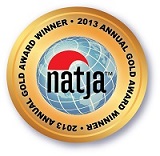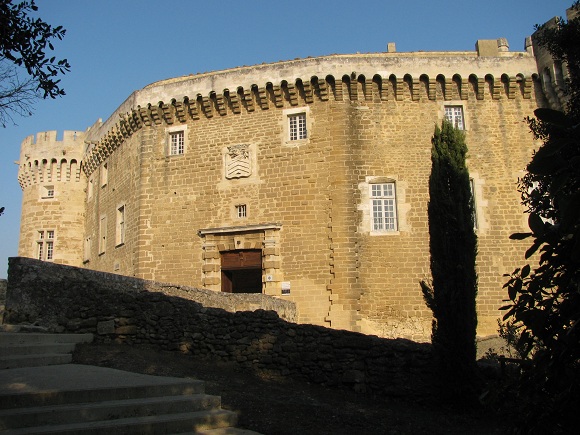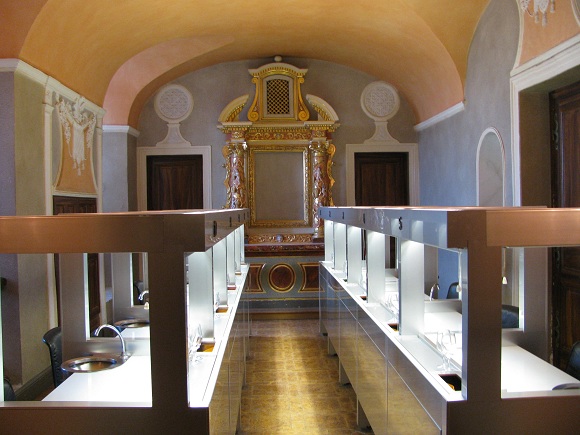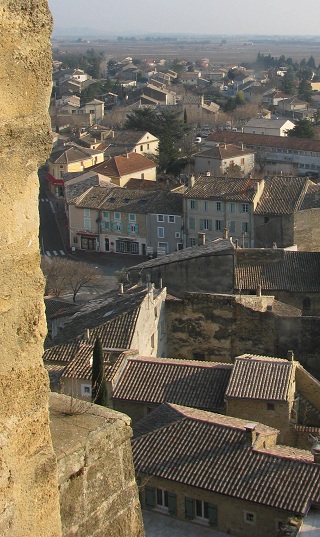
In which the author takes a tasting class at Wine University (Université du Vin) in the medieval castle of Suze-la-Rousse, reflects on whether or not he’s a wine enthusiast, and wonders if it’s true that “there is no pleasure without knowledge.”
* * *
I was never a very conscientious student but I must have done something right because within an hour of eating like a sixth grader I was sitting in a classroom at Wine University (Université du Vin), 16 miles west of Nyons, swirling, sipping and spitting, in no particular order, a selection of lesser-known wines produced in the department of Drome.

In a modern classroom with the walls of the medieval castle of Suze-la-Rousse, I took part in an excellent lesson on regional diversity with a tasting of Chatillon en Diois (Aligoté), Grignan (Viognier) and Brézème (Syrah/Shiraz). There’re nothing like name-dropping to let people know that you’ve traveled.
Indeed, having stopped two days earlier on the way south in Hermitage country (Hermitage, Tain l’Hermitage, Croz-Hermitage) and tasted, among others, M. Chapoutier’s delightfully complex, promising, white Chante-Alouette Hermitage 2010 (Marsanne, biodynamic), the opportunity to discover lesser-known appellations at Wine University was much appreciated.
See, I’ve done it again, name-dropped, this time with a little more detail. Journalists, writers and bloggers do that all the time, especially with regards to travel and wine. We do that to let readers know not only that we’ve traveled but that we’ve traveled to fine places armed with experience and knowledge and returned with even more. The reader is then left with the disturbing task of deciding whether names have been dropped to impress or provided to convey information. You might therefore be wondering: Does this author actually know anything about wine or is he faking it?

Best not to drop too many names or you’ll take me for a wine maven, a wine snob or that certain kind of wine enthusiast who never ceases to amaze and annoy me. I am referring to the enthusiast who, in a non-professional or non-educational setting, will take hold of an assembly to let us know that we cannot progress any further into the evening until he or she has made thorough analysis of the nectar being served.
I certainly understand the desire to share one’s knowledge and one’s opinions. What’s surprising in the case of the self-appointed and gratuitous wine analyst is his momentary (one hopes) inability to stop chewing his wine long enough to look around the table and realize that at that moment the rest of us are being neither educated nor entertained but simply sitting there like a group of hungry non-believers waiting politely for a faith-based table companion to finish saying grace. We don’t mind, really, we’re just waiting for you to finish expressing your vision of the world so that we can proceed with that humanistic ritual called sharing a meal.
I got to thinking of this while at Wine University because it made me question my own relationship with wine. Having visited large swaths of the wine regions of France, written much about them, interviewed producers, sellers and connoisseurs, attended numerous wine tastings in addition to simply tasting numerous wines, given tours of Champagne and Burgundy and the Loire Valley, given lectures about French wine regions in the U.S., and even conducted incredible wine bar tours in Paris—having practically swum in wine some days, what was my relationship with wine?
Did I belong in Wine University?
Université du Vin is an institution for professionals and enthusiasts and for seriously interested students of all ages to further their education in any number of subjects related to wine and the wine industry over the course of a few hours or many months—all this in a historical setting of a medieval castle-cum-pleasure palace-cum-wine university.
The instructors, to judge by my small sampling that afternoon, were clear, expressive, highly trained and able to address questions without condescension.
I enjoyed my taste of Wine University. It appealed to my curiosity. And for a moment there I felt a tinge of heightened enthusiasm at sitting in an actual lecture-like classroom with several glasses, a notepad and a sink in front of me. I briefly imagined myself staying at Suze-la-Rousse for a week: classes in the morning, a hike or a bike ride on a sunny day, an afternoon in the reference library of 6000 works in case of rain, a long dinner with new-found wine friends, followed by a long-earned sleep in a monastic cell, no, make that a cozy B&B. I’ve had similar moments in other settings I’ve imagined staying put in Italy to learn Italian, in Spain to practice salsa, on someone’s couch to study Spinoza.
But I never will—not with much depth; just a curious little flirt, a brief and memorable affair before moving on. I realized during the class that afternoon that I didn’t have a sustained interest in distinguishing between mineral, floral, fruit or animal or in considering acidity versus tannins or in examining the nuances of yellowish whites and purplish reds.
No, I am not an enthusiast. I am curious. I am a curious traveler, a frequent wine drinker, someone who enjoys meeting wine folk, especially in their vineyards and cellars and homes.
Having finished the Chatillon en Diois and now onto the Grignan, an area whose a chateau I’d visited the previous day (see Part 3 of this article), I was well aware that I’m more enthusiastic about old stones than I am about young wines, but I quite like combining the two when I travel.

On the approach, the hilltop castle of Suze-la-Rousse appears to be the model of a medieval fortification with its high uninviting walls and crenellated tower. But once inside it relaxes its defenses and reveals itself to be a pleasure palace with a 16th-century (Renaissance) courtyard and later transformations including a grand staircase and pastel drawing rooms.
Add the multi-layered study of wine to that and you’ve got an institution where French heritage and the contemporary marketplace for wine play off each other like a light show on the façade of a Gothic cathedral. The current spirit of the place is amusingly evident in the castle’s chapel, once a setting for Holy Communion, recently transformed into a temperature-controlled tasting room.
With or without the wine, the chateau can be visited by appointment.

While the training of young and budding sommeliers and cellar-masters/cavistes with professional or amateur ambitions is at the heart at the university, Universite du Vin also offers classes and courses concerning other important aspects of the wine industry: production techniques, markets, marketing, regulations. Diplomas and degree programs in management and marketing, law, production and scientific measures of quality and of tasting are available in conjunction with other educational institutions. Regarding the wine tasting here, there’s naturally a strong emphasis on French wines but other wines are also present.
Created in 1978, Université du Vin now welcomes about 200 students per year along with another 2000 who come for various training sessions. Classes are also available for enthusiasts and other who may or may not arrive with (or admit to) professional ambitions.

To name but a few classes and courses that are open to those, professional or amateur, with a working knowledge of French: a 4-day initiation to wine tasting; a 1-day class in recognizing and understanding flaws in wine; a 1-day class devoted to the olfactory aspects of wine.; a 1-day class in creating a wine cellar and a wine list for your restaurant; assorted 1- to 3-day classes on getting to know the wines of specific wine regions. This year there was also a 3-day class in English on Rhone Valley wines.
These are serious classes taught by highly trained professions and are not intended as sales pitches for any specific wines or regions, despite the natural presence of many Rhone Valley Wines. You’re more likely to come across enthusiasts rather than budding professionals at a weekend initiation. Wine University also opens its doors to business tourism, e.g. team building or incentive travel in English plus seminar rooms for their more mundane corporate work. For those willing to devote less than a day to educating their palate, there are occasional classes in tasting cheese, olives and olive oil or beer.
Some say that there is no pleasure without knowledge while others feel that knowing that you’ve enjoyed yourself is knowledge enough. I’ll take both as companions as I pursue my own wandering approach to a wine education.
© 2012, Gary Lee Kraut
– Return to Part 1 of Drome Provencale: Eat Like a Sixth Grader, Drink Like a Wine Enthusiast
– Go to Part 3, Drome Provencale: Medieval Towns, Castles, Lavender and Silk
Part 2 endnote: More Rhone Valley name-dropping
Planted more or less from Vienne (just south of Lyon) to Avignon, Cotes du Rhone (including Cotes du Rhone Villages) vineyards extend along both sides of the Rhone River, increasingly to the east as one head’s south, with many appellations along the way.
Concerning the red wines, which predominate, the northern portion of the valley, from Vienne to Valence is known for its expression of Syrah/Shiraz grapes from Vienne to Valence (e.g. Côte Roie, Contrieux, Chateau-Grillet, Saint Joseph, Hermitage, Cornas, Saint Peray). In the southern portion, from Montelimar to Avignon, there’s a dominance of Grenache along with some use of Syrah, Mourvedre and other varieties (e.g. Gigondas, Vacqueyras, Chateauneuf-du-Pape, flaring off to Tavel).
Transforming grapes grown over 60,000 hectares (nearly 148,000 acres) and divided into 6000 winegrowing business, the Rhone Valley produces 334 million bottles per year. More details about this long vertical wine region along the route from Lyon to Avignon can be found here.


Bonjour. I don’t know if I’ll ever make it to Drome but you’ve led me on a journey back to sixth grade and then to a wine-tasting class that I took a number of years ago, and for that I thank you! I look forward to further “journeys.”
Janet